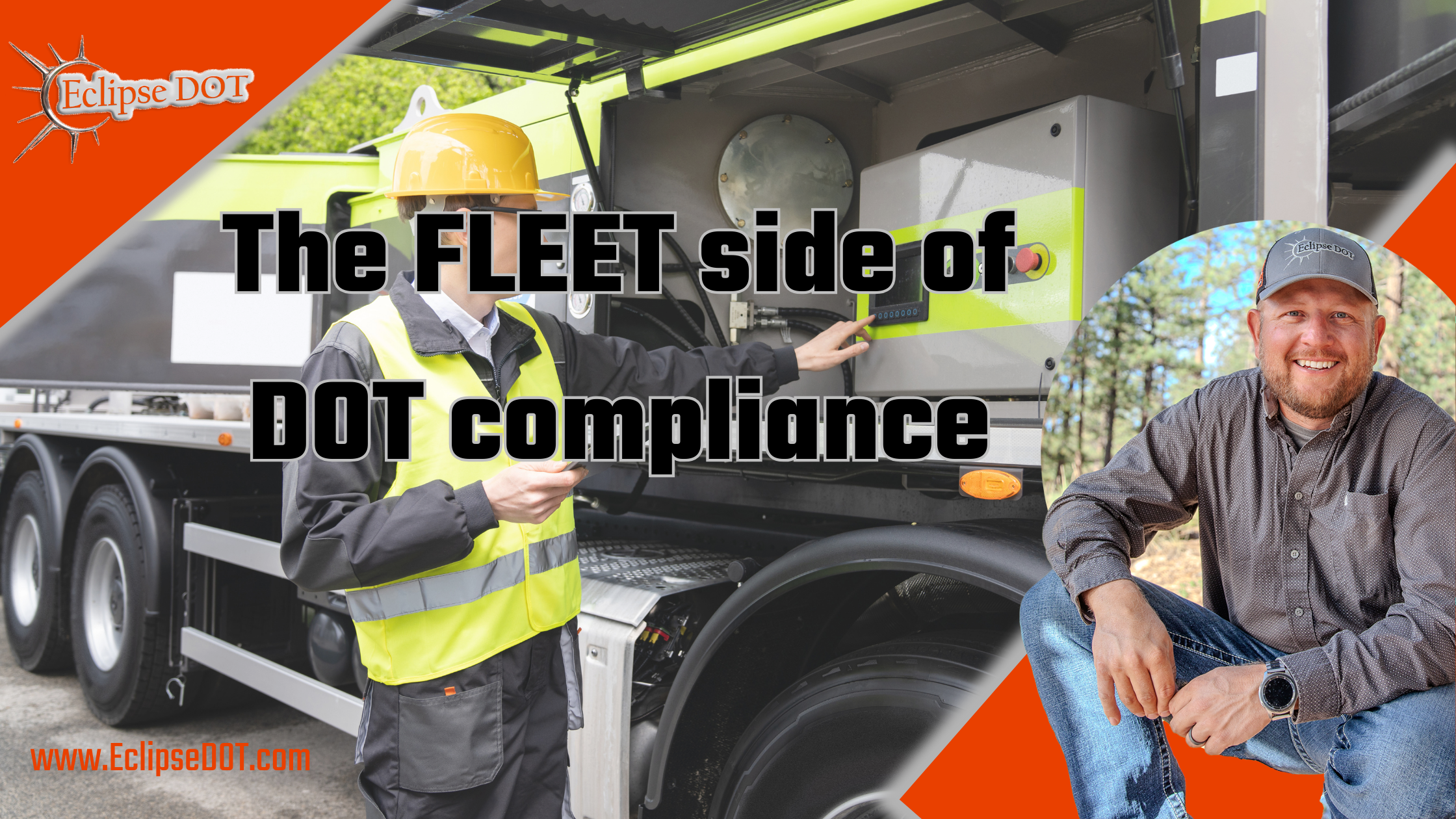The FLEET side of DOT compliance
We Have Been Getting A Ton Of Questions Around The Fleet Side Of DOT Compliance
Let’s start with all the companies that send you letters saying that you’re out of compliance and in danger of being fined $10,000 a day if you are not in compliance.
Have you ever gotten one of those letters?
We feel that this should be illegal, and we know that it is immoral to send those letters out.
Unless the letter is from the FMCSA and has their symbol on it, don’t worry about it. It’s just a “schistery company that is trying to scare you into giving them your business.
MCS 150
Your MCS 150 needs to be updated every 2 years, and your DOT number tells you everything you need to know about when it has to be updated. US DOT 1234567 The last number in your DOT number tells you when it needs to be updated. For instance, 1 means January, 2 means February, 3 means March, 4 means April, 5 is May, 6 is June, 7 is July, 8 is August, 9 is September, and 0 is October.
The second to last number of your DOT number tells you if you updated on odd or even years US DOT 1234567. If it is an even number, then you need to update your MCS 150 in even years. If it was an it was an odd number, then you would update it for odd years.
And if your USDOT number is 1234567, then your MCS 150 would need to be completed by June of even years.
Note that you can update your MCS 150 as often as needed, but it must be done at least once every 24 months.
Make sure that you report accurately when you update anything for the DOT.
If you have your DOT Pin number, you can update your MCS 150 for free at this website: https://li-public.fmcsa.dot.gov/LIVIEW/PKG_REGISTRATION.prc_option. It’s fairly simple, but if you would like any assistance, please don’t hesitate to reach out to our team.
UCR (Unified Carrier Registration)
The UCR is only for commercial vehicles that operate in interstate commerce.
It’s just another tax for Interstate CMVs.
A CMV is defined by the federal government as any vehicle that has a GVWR (gross vehicle weight rating) over 10,000 pounds and is used in interstate commerce. If you are not registered with the UCR and are operating in interstate commerce, then you could get detained at a port of entry (POE) or roadside inspection.
The UCR is extremely easy to complete; in fact, if your MCS-150 is up-to-date then the system can pull those numbers directly from the FMCSA.
Most years, the UCR is required to be completed by December 31st. It depends on the year when it opens. If the government is struggling to define the costs, I have seen it open as late as March; if they have the costs already determined, I have seen it open as early as September.
If you have both intrastate and interstate vehicles, you can use exemptions when filing. And it might lower the cost of your UCR. Make sure that you are reporting accurately and not fabricating your numbers to get a lower cost.
The website for the UCR is www.ucr.gov.
IFTA (International Fuel Tax Agreement)
IFTA is the easiest way to file and pay fuel taxes for each state you drive into. Unlike UCR, IFTA is only needed for vehicles with a GVWR over 26,000 pounds that are crossing state lines.
This renews every year on January 1st, and it is fairly cheap to get the license and decals for your company. Most decals are under $5, and the licenses are usually included with the decal fee.
A few things that you need to remember for IFTA are that you must track your fuel purchases and miles driven in each state for every truck that has IFTA on it. You will also need to track which decals are placed on which trucks. Both of these are as simple as keeping a spreadsheet and your fuel receipts.
If you would like an example spreadsheet, click here, and we’ll send it directly to your email.
All companies that utilize IFTA do not need to buy fuel permits for each state to travel in for every trip. It saves you a ton of time and, in the long run, money if you are crossing state lines regularly.
Note that you must report every quarter your fuel purchase, where it was purchased, and the miles you drove in each state. This is reported to the state where your IFTA was originally purchased, and that should be the state where your vehicles are registered.
Few States That Require More Than IFTA And You Need To Know About Them Too
Each of those states requires an additional annual permit and also requires that you file with them quarterly.
New York State imposes a highway use tax (HUT) on motor carriers operating certain motor vehicles on New York State public highways (excluding toll-paid portions of the New York State Thruway). The tax rate is based on the weight of the motor vehicle and the method that you choose to report the tax. Their website is https://www.tax.ny.gov/bus/hut/huidx.htm.
Kentucky KYU is a tax license issued for all carriers traveling on Kentucky roadways with a combined license weight greater than 59,999 pounds. Their website is https://drive.ky.gov/motor-carriers/Pages/KYU.aspx.
New Mexico imposes a weight-distance tax on owners, operators, and registrants of intrastate and interstate commercial vehicles with a declared gross vehicle weight over 26,000 pounds. This tax is based on vehicle weight and miles traveled on New Mexico roads. Companies must register and apply each year for a New Mexico Weight Distance Tax Electronic Permit for each vehicle.
IRP (International Registry Plan)
The IRP takes place of your typical registration for your CMV’s that have a GVWR or GCWR (Gross Combined Weight Rating) of over 26,000 lbs. This is extremely useful when you are crossing state lines regularly.
Here’s the thing: if you don’t have IRP on your CDL vehicles, then you have to get a “trip” permit every time you travel in any state other than the state your vehicle is registered in.
Let’s say that your truck is registered in Colorado but not registered as an IRP. You haul it to Arizona for a job. You would need to get a temporary registration to operate that vehicle legally while you are not in Colorado.
If you had IRP on that truck, then you would no longer need the temp registration for the other state.
There are several things you should know about IRP. One is that it is good for one year from the date you purchase it. You will also need to know the miles driven in each state so you can file those when you renew after the first year.
Each truck will get a cab card, which takes place at the time of registration for that vehicle. That document needs to be kept in the vehicle.
2290 (Heavy Use Tax)
The heavy use tax is required to be filed annually for every vehicle that has a registered gross weight of over 55,000 lbs. 2290 must be filed, and the taxes due must be paid to the IRS by no later than July 31st.
There are several factors contributing to this tax. One is where your vehicles are registered. The second is how many miles they have driven annually.
You can get the 2290 form here. https://www.irs.gov/forms-pubs/about-form-2290
Hopefully, this helps you to know when everything is due and what exactly is needed to help keep your fleet in compliance so you can continue to operate your CMV’s and move your company forward.
Until next time, stay safe and keep the rubber side down.
Discover our CDL & DOT Compliance blog for an exclusive trial at DOTDocs.com. Also, claim your FREE micro audit at THE ECLIPSE DOT MICRO AUDIT. Ready for smoother operations?





